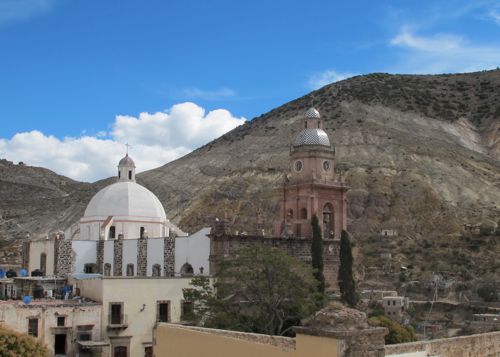
Note: This is the first in a series of articles, “Battle for the Birthplace of the Sun,” reporting from the Sierra of Catorce on the historic pilgrimage of the Huicholes to their threatened sacred site of Wirikuta. Stay tuned for developments as they unfold in the days ahead.
REAL DE CATORCE, San Luis Potosi, Mexico – A quiet but excited buzz hums through the streets of this normally sleepy ghost town turned tourist attraction. Hotels that languished for months are filled to bursting and people are camping on every spare piece of real estate. Everyone is awaiting the arrival of hundreds of Wixarika pilgrims from their homelands in the Western Sierra Madre — a historic mass pilgrimage to connect with the spirits of their ancestors and to pray for the renovation of the fading candles of life that reside in this place, the depleting water supply and the continued equilibrium of all life on Earth.
The Wixarika, more commonly known by their Spanish name, the Huicholes, hope to gain some insights in a historic “spiritual consultation” regarding the threats to their most sacred site, Wirikuta. The Huicholes have made their millennial pilgrimages to Wirikuta since the beginning of their history, and see it as their holiest altar of prayer, the place where they come to hunt their sacramental cactus, the peyote, and the place where the sun was born; but this protected reserve is the target of Canadian mining companies and agroindustrial businesses that see it as a resource to exploit.
This UNESCO-recognized natural and cultural reserve is also home to some of the world’s richest silver veins, exploited for centuries by the Spaniards and then left to languish — until now, when new mining methods and rising silver and gold prices have made the area attractive once again to the mining industry. But besides the cultural significance of the site, the region is also one of the most biodiverse desert regions on the planet and home to a number of endemic and endangered species.
I arrived last night in this picturesque colonial mountain town in the company of Carlos Chavez, coordinator of the Wirikuta Defense Front, and got a quick debriefing from Mercedes Aquino, who is heading up the local support effort. Tensions have risen here for the past year since First Majestic Silver Corp. announced plans to open a silver mine, with those who depend on the tourism industry at odds with those who hope to make a living from the mines.
Organizers were worried yesterday about reports that pro-mining forces were gathering and possibly mounting an unfortunate response to the event, but Mercedes was breathless and glowing when we arrived; she and several others went on the air on the community radio station to head off a possible confrontation, explaining the purpose of the pilgrimage and putting people’s fears to rest. And this morning, priests all over the diocesis are urging their parishioners to exercise tolerance and support the pilgrimage in their own way tomorrow night, praying along with the Huicholes from their own homes for water and for life.
“We explained that the Huicholes are coming here to pray for life, to pray for the water, as they have for centuries. And just as they began to arrive, it began to rain. It’s like a miracle, really.”
Like all of northern Mexico, Wirikuta is suffering the worst drought in more than 70 years; the rains never came to Wirikuta this year, and the crops all failed. Many locals are hoping the proposed mines will provide much-needed employment, despite concerns that it will contaminate and deplete the scarce water reserves. So the timing of last night’s cloudburst, and the predicted rain of the next few days, is really quite remarkable.
Organizing the support for this pilgrimage has been a tall order the Wirikuta Defense has had to fill; from the moment the Huicholes made the decision to make this pilgrimage, just a few weeks ago, it has fallen to the small, unfunded and overworked defense group to try and pull together the logistics and smooth things over in the local communities. Somehow they managed to raise most of the nearly half-million pesos necessary to rent buses, buy food and firewood and pull together a thousand other details, and now about a dozen buses filled with Huicholes, in addition to countless individual bands, are making their way here from hundreds of ceremonial centers spread out over the Wixarika territories some 400 miles to the west. Their plan is to converge on the Cerro Quemado, the sacred mountain where they believe the sun was born, on the night of Feb. 6, where they will hold an all-night ceremony of prayer.
Anthropologist Paul Liffman, author of Huichol Territory and the Mexican Nation, called the pilgrimage “unprecedented in recent history — maybe unprecedented, period.” Normally the pilgrims organize their annual journeys to Wirikuta individually, and each of the more than 500 ceremonial centers sends their own group of maraka’ames (shamans) and jicareros (guardians of the sacred sites) over the course of the year. This mass pilgrimage and ceremony is a response to what they see as a mortal threat to their culture, Liffman said. It’s also a result of the logistical and financial support of the civil society and a growing awareness of the media.
Meanwhile, Chavez takes the long view. “What we’re seeing here is a concentration of the challenges that humanity is facing everywhere,” he said. “It’s going to be extremely important that a sustainable alternative livelihood is provided to the local communities,” he said. “What we’re hoping for and working towards is a big project of restoration — this is such an important area and we can make of it an example of sustainable development for the world.”
For more information about the movement to save Wirikuta, see Wirikuta Defense Front. For more information about this issue and others working throughout the Americas for a more sustainable future, see The Esperanza Project.





















